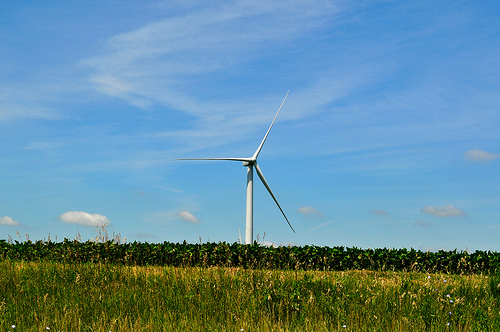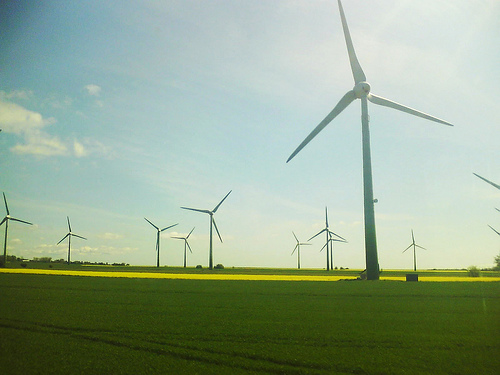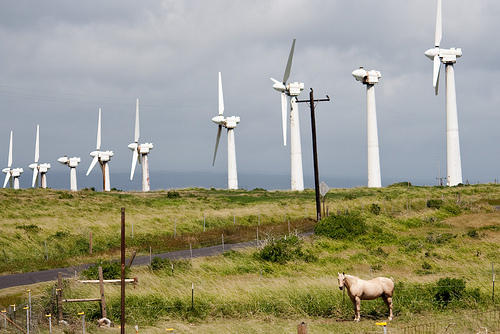Wind farm sickness: Public health concern or hypochondria?

Wind farms may be the answer to our growing energy crisis. Affordable and safe (compared to most traditional energy sources), wind farms are a lasting and sustainable form of energy production. But some people contend that they are anything but harmless.
(Incidentally, bird strike fears have proved somewhat overblow. The average wind turbine kills two birds per year. Whereas the average outdoor housecat kills two birds per week. Bird lovers concerned about wind turbines would do well to keep their cats indoors.)

Image courtesy Flickr/snurb
Dubbed "wind farm sickness," this syndrome seems very real to its sufferers, but has not stood up to scientific scrutiny. The effects of wind farm sickness are vague and difficult to quantify. Sufferers report experiencing headaches, stomach aches, feelings of malaise and dizziness. (Compare these to the symptoms reported in neighborhoods downwind of coal plants: asthma, mercury poisoning, and congestive heart failure.)
Wind farm opponents blame wind farm sickness on the (imagined) effects of (theoretical) ultralow frequencies being transmitted from the vibrations of the wind turbines. However, several studies have shown that the only thing which correlates to wind farm sickness - and it is a strong correlation - is the sufferer's baseline levels of anxiety, and their exposure to frightening stories about wind farm sickness.
One recent study showed that participants had no difference in reactions between sitting in a room being bombarded with ultralow frequencies and one which was not. However, their reactions were correlated to whether or not they had first been shown a news story about people suffering from wind farm sickness. Those who had seen the clip became ill; those who were shown a neutral clip did not.

Image courtesy Flickr/imotov
"We need more research," activists respond. But how much research is enough? As with so many fringe theories and ailments, the answer is "There hasn't been enough research until we find proof that my claim is true." This belief in the unfalsifiable is a hallmark of pseudoscience.
Wind farm sickness is also not evenly distributed, as you would expect to see if it were a genuine problem caused by wind turbine farms. Instead, it strongly clusters in areas where "scaremongers" have been active. In other words, you only get wind farm sickness if you are a highly anxious person, and someone tells you that you might have wind farm sickness.
The surprising conclusion drawn by a team of Australian researchers is that "wind farm sickness spreads by word of mouth." Their research showed that wind farm sickness was essentially being inadvertently spread by anti-wind-farm activists who went door-to-door stumping for the prohibition of wind farms because they cause wind farm sickness. It would be ironic if it weren't so sad.
(One could also draw a more distressing and cynical conclusion from the research: That "sufferers" are deliberately faking illness in order to gain leverage against a public utility which they perceive as lowering their property values.)
Interestingly, wind farms hit the same high notes as several other sources of pseudo-illness like cell phone towers and wireless internet networks in public areas (like schools). They are high tech, their effects are invisible, and their existence and usage is completely out of the control of the sufferers.
At the heart of wind farm sickness and other such reactions to modern technology may a feeling that "I don't want it, but I can't make it go away." It's a sort of judgmental, ethical NIMBYism that feels it has to resort to claims of illness in order to be heard against the tide of public opinion in favor of the technology.
I have sympathy for this situation, I really do. But the world needs electricity, and I don't see any of the wind farm sickness sufferers volunteering to do without it in order to reduce the load on the electrical grid, thus causing the wind farms to be unnecessary. Electricity has to come from somewhere, and wind farms are still a far sight better for the environment and the health of their neighbors than, say, coal plants or nuclear power plants.
Another theory is that these somewhat mysterious-to-the-common-person technologies become the psychiatric lightning rod, taking the blame for all of the vague complaints of the sufferer. Ailments which are no less real for having been caused by anxiety (not wind turbines or cell phone towers).
Main image courtesy Flickr/shock254

2 comments